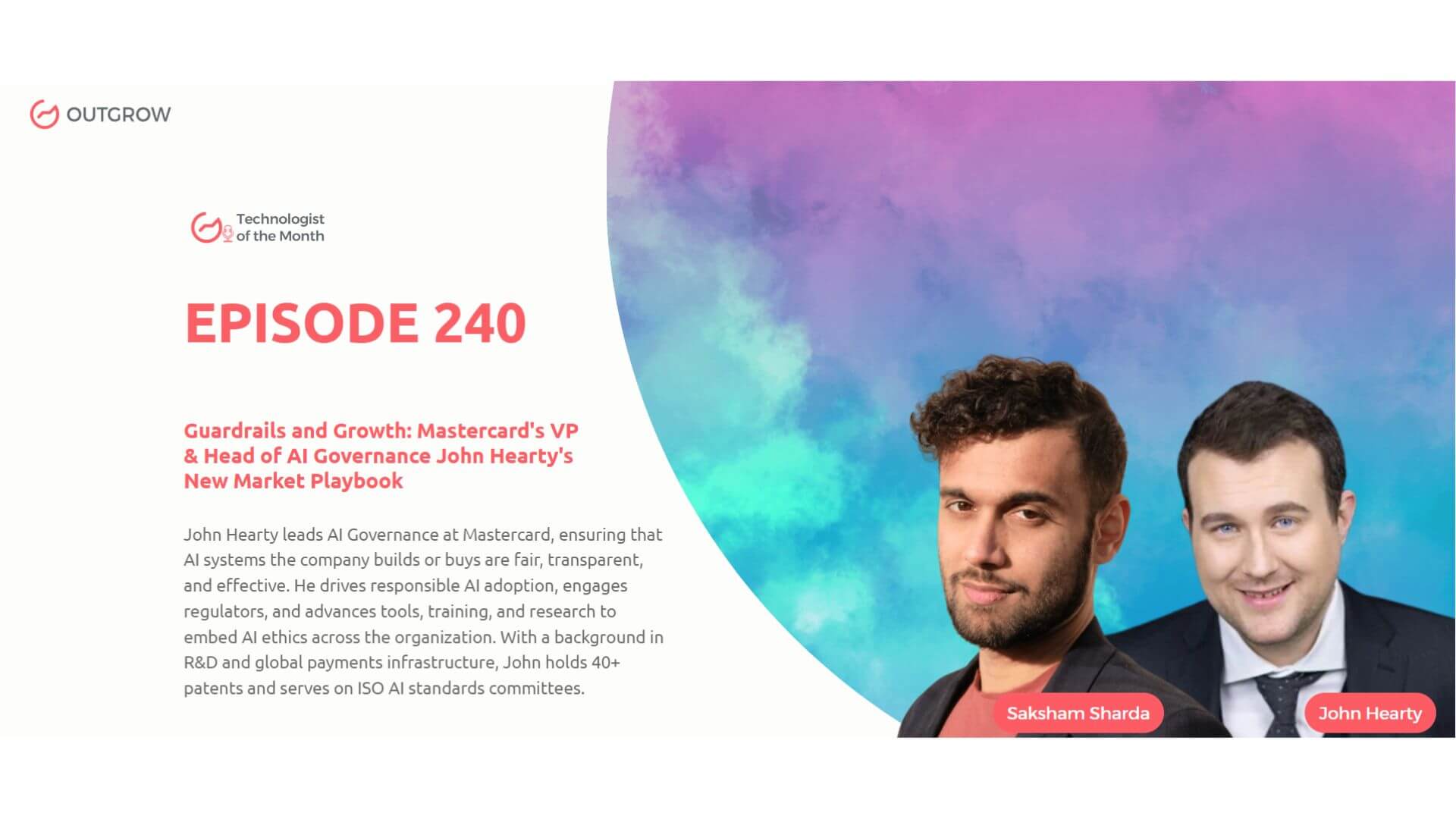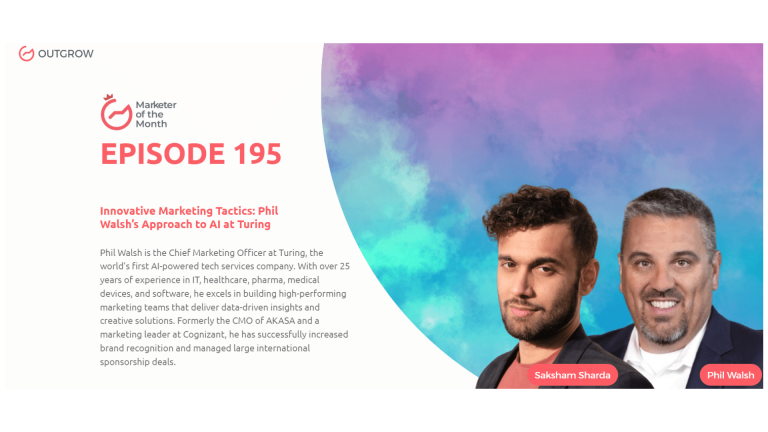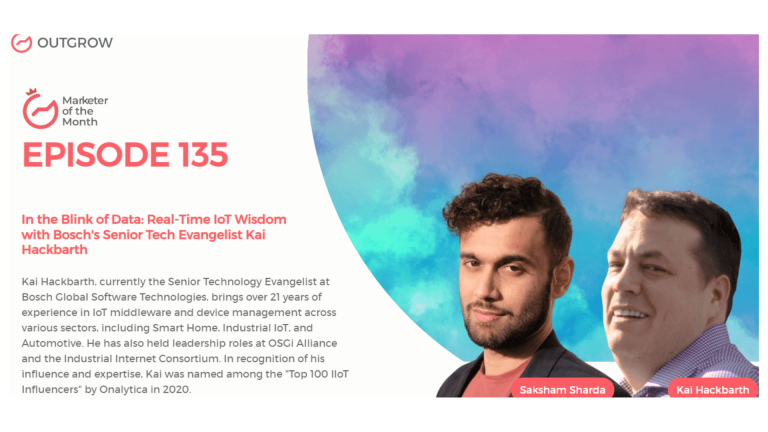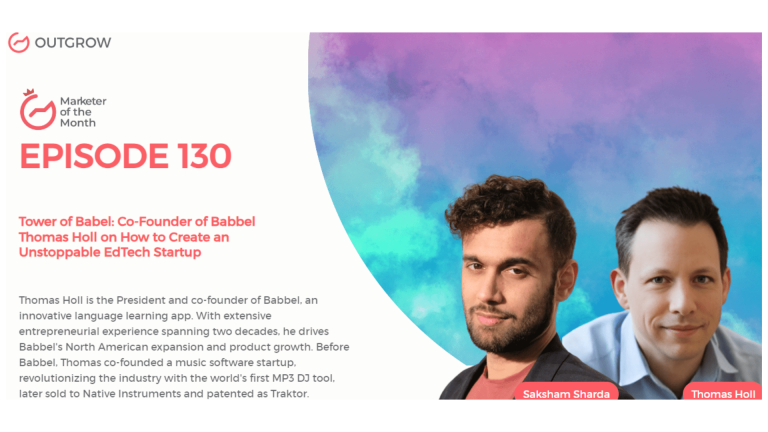EPISODE 240: Marketer of the Month Podcast with John Hearty
Table of Contents
Hey there! Welcome to the Marketer Of The Month blog!
We recently interviewed John Hearty for our monthly podcast – ‘Marketer of the Month’! We had some amazing, insightful conversations with John, and here’s what we discussed about-
1. Trust as foundation: Mastercard’s AI governance philosophy explained
2. Evaluating AI systems for efficacy, fairness, and transparency
3. Generative AI’s transformative impact on marketing and creativity
4. Building responsible AI solutions with external suppliers effectively
5. The evolution from R&D to AI governance leadership
6. The future of marketing in chatbot and agent-based systems
About our host:
Dr. Saksham Sharda is the Chief Information Officer at Outgrow.co He specializes in data collection, analysis, filtering, and transfer by means of widgets and applets. Interactive, cultural, and trending widgets designed by him have been featured on TrendHunter, Alibaba, ProductHunt, New York Marketing Association, FactoryBerlin, Digimarcon Silicon Valley, and at The European Affiliate Summit.
About our guest:
John Hearty leads AI Governance at Mastercard, ensuring that AI systems the company builds or buys are fair, transparent, and effective. He drives responsible AI adoption, engages regulators, and advances tools, training, and research to embed AI ethics across the organization. With a background in R&D and global payments infrastructure, John holds 40+ patents and serves on ISO AI standards committees.
Guardrails and Growth: Mastercard’s VP & Head of AI Governance John Hearty’s New Market Playbook
The Intro!
Saksham Sharda: Hi, everyone. Welcome to another episode of Outgrow’s Marketer of the Month. I’m your host, Dr. Saksham Sharda, and I’m the creative director at Outgrow. co. And for this month, we are going to interview John Hearty, who is the VP & Head of AI Governance at Mastercard.
John Hearty: Great to be here. Thank you.
Don’t have time to read? No problem, just watch the Podcast!
Challenge yourself with this trivia about the exciting topics John Hearty covered in the podcast.
Or you can just listen to it on Spotify!
The Rapid Fire Round!
Saksham Sharda: Let’s go. So let’s start with the rapid-fire round to break the ice. The first question is, at what age do you want to retire?
John Hearty: Now.
Saksham Sharda: How long does it take you to get ready in the morning?
John Hearty: Forever.
Saksham Sharda: Most embarrassing moment of your life.
John Hearty: Teenagerdom.
Saksham Sharda: Favorite color?
John Hearty: Blue.
Saksham Sharda: What time of day are you most inspired?
John Hearty: Evening.
Saksham Sharda: How many hours of sleep can you survive? One.
John Hearty: Eight.
Saksham Sharda: The city in which the best kiss of your life happened?
John Hearty: Vancouver.
Saksham Sharda: Pick one. Mark. Zuckerberg or Elon Musk.
John Hearty: Neither.
Saksham Sharda: How do you relax?
John Hearty: Kitten.
Saksham Sharda: How many cups of coffee do you drink per day?
John Hearty: Two.
Saksham Sharda: A habit of yours that you hate
John Hearty: Over planning.
Saksham Sharda: The most valuable skill you’ve learned in life.
John Hearty: Patience.
Saksham Sharda: Your favorite Netflix show.
John Hearty: Squid Game.
Saksham Sharda: Are you an early riser or a night owl?
John Hearty: Night owl.
Saksham Sharda: One-word description of your leadership style.
John Hearty: Supportive.
Saksham Sharda: Coffee or tea to kickstart your day?
John Hearty: Your daily coffee
Saksham Sharda: Ideal vacation spot for relaxation.
John Hearty: Train travel.
Saksham Sharda: Key factor for maintaining a work-life balance.
John Hearty: Self-Discipline.
The Big Questions!
Saksham Sharda: Alright, well, that was the end of the rabbit by rounds. Sure. I can go to the longer questions. The first one is what it is like to hold 40 patents.
John Hearty: Well, getting up towards 50 now, which is frankly an honor. I work with brilliant teams who create novel things. I feel very honored to be part of that work.
Saksham Sharda: And what’s the process of getting a pattern for people who don’t know? Like is it tough? Is it easy? But like, what’s it like?
John Hearty: We are supported by a very good patent legal team. So the process of getting a patent is you describe your invention, you work with counsel to draft a filing. You may make a provisional filing if you’re still working on the technology and it’s not finalized. And then, a final filing later, you’ll have interviews with the lawyers so that they understand how to describe it. Then they’ll create diagrams. You’ll review all that material. Then the patent will be filed, and you’ll wait a few years to find out if it was accepted.
Saksham Sharda: So MasterCard is a global brand that relies on trust and transparency. How do you use AI and data governance to enhance customer trust and marketing effectiveness at scale?
John Hearty: Trust is essential at MasterCard; our CEO, Michael Miba, has publicly and consistently said that the only AI is trustworthy AI as far as we are concerned. So MasterCard’s AI governance program is fundamental to establishing that trust. What we do is we assess every system, every AI system that MasterCard builds and buys, we evaluate them for efficacy, fairness, and transparency. We identify the controls that need to be implemented, and we work with teams to implement those controls. We monitor compliance with that. We work with other partner teams who manage security, privacy, and enterprise risk levels. And if that were the whole story, it wouldn’t be as interesting. What we do to ensure customer trust is that we enable responsible practices as well. That’s about distributing tools, that’s about providing support and guidance. That’s about training, that’s about really everything that’s needed for AI to be built in a trustworthy way, the first time, so that when you go to a valuation, it passes the first time.
Saksham Sharda: As AI becomes integral to customer engagement, how do you balance innovation in AI marketing tools with MasterCard’s regulatory and compliance requirements?
John Hearty: Sure. We’ve seen a huge uptick in engagement with AI, with the launch of generative AI systems with GPT-3.0.5 and everything that came afterwards. And that innovation and those ideas are remarkable. We make it easy to develop and procure systems that are responsible, that pass validation. So we distribute tools, we distribute support, guidance. We’ve developed a generative AI evaluation service that we use not just internally, but with our suppliers to help them. Third parties validate that their AI systems are meeting high levels of efficacy. So avoiding hallucinations that they are inclusive, that they are transparent
Saksham Sharda: Collaboration between marketing, product, and AI governance teams can be complex. How do you align these diverse stakeholders around shared data and marketing goals?
John Hearty: Yeah, so MasterCard starts there with a very robust set of data and tech responsibility principles. What we build needs to work, it needs to be inclusive, it needs to be transparent. And those principles unify everyone around a set of values. But even with people rallied behind that goal, it still needs to be, we still need to make it as easy as possible and as clear as possible. What needs to be done to make a system responsible, make it trustworthy? So if we engage, if we engage with a supplier Pre-Contract, we know we need to know what the supplier needs to do. We need to be able to explain it to them clearly. We need to be able to create confidence, not just in our business owner in marketing, but also in the supplier team. That this is not going to prevent them from doing what they need to do, but it’s gonna put guardrails around it. And if we can innovate responsibly in that way with everything we build and buy, then we are able to innovate without slowing down, and we’re able to do things responsibly.
Saksham Sharda: AI is transforming both backend systems and customer-facing initiatives. What excites you most about its role in marketing at MasterCard?
John Hearty: Marketing is one of the areas where generative AI applications have been most exciting, most diverse, and most a really in terms of adoption. We’re seeing not just an increase in the use of AI tools, but also this, this upsurge in the variety of experiences. So interactivity now is possible at a greater level than it used to be. You can do things with media that you never used to be able to do. And I think that the effects of that are transformative. We’ve seen, as I mentioned, an uptick in volume, but and variety. And I don’t think that’s stopping anytime soon.
Saksham Sharda: Designing AI systems for marketing requires balancing technical rigor with human-centric design. What’s your approach to building AI solutions that marketers can trust and adopt?
John Hearty: One important thing to note here is that a lot of marketing solutions in the enterprise may be purchased from external developers. So it isn’t just about building, we may build, say 50% of what we’re using in some across the business overall, but it might be much more like five to 10% in marketing at this point in time because everyone’s experimenting with new experiences. So we need to make sure not just that we are building solutions internally that marketers can trust and adopt. And that is essential. And that’s about building shared capabilities and monitoring and tracking all of the different use cases that are happening across the organization in order to be able to say, okay, here are common capabilities. If we build this set of things, this will raise the level for marketers in general. We take that approach in our AI strategy, and we take that approach in our AI governance. When it comes to establishing trust, it’s, we commonly want to do applications with text applications, with images. We commonly want to prepare, maybe it’s materials that are generated using AI that are sort of static, and then distributed. Maybe it’s material, maybe it’s, but maybe it’s experience where you go in and you provide your own input and then you get personalized output, right? And that sort of thing. That requires consistent evaluation tools and support for not just internal builders, but external ones. So that we can say for every marketing solution that we put out there that leverages AI, we know this is built responsibly. We know this is effective, we know this is transparent, we know this is inclusive, we have the receipts
Saksham Sharda: So, looking ahead, which AI data and marketing trends do you believe will define MasterCard’s approach in the next five years?
John Hearty: God, I think we’re just getting started. I really do. I think that we will see a continuation of tapping into generative AI, and we will see two things there. We’ll see people learning what really works and what doesn’t, what moves the needle. And we’ll see people identifying what common capabilities are essential and just sort of table stakes for participating in marketing in this AI-based paradigm. I think that we will see more experimentation, and I am really interested to see whether we start seeing more integration of marketing directly into chat and agent tools and systems. So many people right now use chat systems for recommendations, discovery advice, and we are building third-party systems, on the end of that, that provide, you know, recommendations, discovery, advice about my corpus of data. But I would be surprised if, over time, we don’t see more of a shift where the same way the internet and marketing strategy on the internet evolved. I think it will evolve similarly in the generative AI, the chatbot, and agent space, because these are tools that everyone is using, and you wanna be able to market to them where they are.
Saksham Sharda: And so, overall, how does one go about embedding AI ethics into an organization like Mastercard?
John Hearty: Hmm. I’m gonna think for a minute. We can cut this bit, and then I’ll answer it. When I first started in AI governance, running AI governance at MasterCard, we did a lot of what we did manually. We did it perhaps slightly differently from system to system. And we were learning what needed to be done. And the journey that we went on was one of recognizing that we needed to be a good partner to our marketing teams, to business owners, to data science teams. And so we started to standardize what we needed, but in intelligent ways that enabled innovation and enabled our standardized approaches to fit every system. We started automating what we’d standardized, and we started accelerating time to governance. We started reducing the amount of effort and work involved to become compliant. And that’s been our philosophy. It’s been about managing the amount of work we’re creating while establishing and maintaining a good standard of governance. It’s been about managing efficacy, fairness, and transparency risks in particular. And it’s been about recognizing that our influence is essential, our ability to work as a constructive partner with other people, and have them want to work with us is vital.
Saksham Sharda: What is your typical day at MasterCard look like?
John Hearty: What a good question. I start the day, I’m based in London. My team is spread between the West Coast really and and, and Eastern Europe and the Middle East. And so every day when I wake up in the morning, there are things to address. And so I start there. I start working on what matters most to me, I take a look at what matters most to me yesterday, and I start meeting with members of my team to say, okay, these are the efforts we’re driving. These are the synergies I want you to drive between yourself and other leaders. Tell me, gimme status updates on what’s happening here. And I want to empower and support my leaders. So I prioritize making sure that they’re able to do what they need to do with my support. With a thousand different competing commitments on your time, you need to be able to prioritize what matters most. And consistently, I found that what matters most is to empower the people you work with, your partners, your managers, and leaders, and to help them do their best work because then you’re multiplying your impact in the organization. So I very much structure my day around that kind of thing. I tend to get a period of time early in the day where I’m able to work through like everything I want to do. I write documents, I edit, I review, and then, as I get later into the day, it’s meetings with us.
Saksham Sharda: How much of your time is actually taken up by meetings in a day on an average?
John Hearty: I got long COVID a few years back, and it forced me to really rethink my approach to my work-life balance because the energy commitment involved in meetings was demanding for me for a while. And so I have a policy now of making sure that a certain period of every day is open to me to be able to drive, do work, think, and plan. And then I do about, honestly, five, maybe sometimes six hours a day of me
Let’s Conclude!
Saksham Sharda: Thanks, everyone for joining us for this month’s episode of Outgrow’s Marketer of the Month. That was John Hearty, who is the VP & Head of AI Governance at Mastercard.
John Hearty: Great to be here. Thank you.
Saksham Sharda: Check out the website for more details and we’ll see you once again next month with another marketer of the month.

I am a Digital Marketing Enthusiast with a passion for optimizing content and paid marketing strategies. Continuously seeking innovative approaches to boost ROI and engagement at Outgrow.









